Rififi, 1955, directed by Jules Dassin, screenplay by Jules Dassin, René Wheeler and Auguste Le Breton, from the novel Du Rififi Chez les Hommes by Auguste Le Breton.
I'm a big fan of adaptations that subvert their source material. I'm not talking here about, say, retelling the Divine Comedy from Brutus's perspective, which unless you are Tom Stoppard or John Gardner is likely to yield garbage.1 But when a filmmaker critiques the flaws, absurdities, and hidden assumptions of a text, there's a chance of producing great art: movies like Kiss Me Deadly, Starship Troopers, or Star Wars: Episode I - The Phantom Menace. Of course, in these cases, the filmmaker at least had strong feelings about their source material. Rififi is the rare example of a director adapting a novel which he not only loathed but would never have chosen to work on at all, except for the fact that he was afraid he'd never work again. (It strikes me that this may not be as rare as I assume, so let's call it the rare successful example.) By the time Du Rififi Chez les Hommes landed on Dassin's desk, he'd already been on the blacklist for years; after fleeing the United States in order to find work, he'd had two Italian productions halted by the long arm of Roy Brewer. Since his choices seemed to be "film this novel you hate," or "never work again," Dassin had to find a version of Auguste Le Breton's story he wouldn't hate himself for filming. By all rights, this should have produced a script written, as Betty Schaefer would say, "from hunger." Instead, Dassin stretched out the ten pages that interested him into a quarter of the film's running time, savagely critiqued what was left, and in the process more or less invented the modern heist film.
Dassin pretty thoroughly subverts the novel (and noir generally) by letting the undercurrents of misogyny bubble unpleasantly to the surface. The film's main character is Tony le Stéphanois, fresh out of prison and trying to avoid going back. He's played by Belgian actor Jean Servais, a recovering alcoholic whose face looks like he'd really done a five year stretch.

Tony is exceptionally cruel to women even by the standards of noir. Nearly the first thing he does after leaving prison is visit his ex-girlfriend, who didn't wait for him while he was in prison. The reunion between the betrayed man and deceiving woman is almost an obligatory scene in noir (which tells you something about the genre right there). Typically, this scene gives the hero the chance to demonstrate onscreen mastery of and indifference to women. Here's how the ur-noir Out of the Past handles it:
Notice how fun that is for the audience, how pleasurable, while being rather a miserable experience for Jane Greer. Mitchum has all the best lines and dominates every frame. Even when he's leaning on the desk and she's standing, they are nearly the same height, and she is constantly leaning in, tilting her head toward him. As adolescent fantasies go, it's right up there with "Madam, I never eat muscatel grapes." Don't get me wrong, I love Out of the Past. But I'm not trying to live in it, and unfortunately, Tony in Rififi is.
Dassin lets his unpleasant hero start the scene promisingly: Tony strolls commandingly across the floor of the nightclub and gets an eyeline match that pretty clearly shows who's in charge. Here's his entrance.
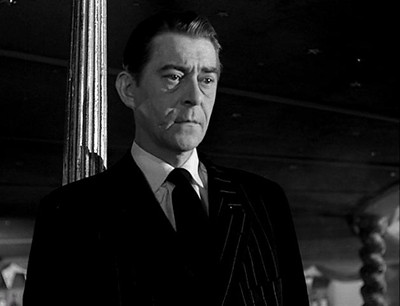
And Mado, played by Marie Sabouret, looking up, like her worst nightmare has just come true.
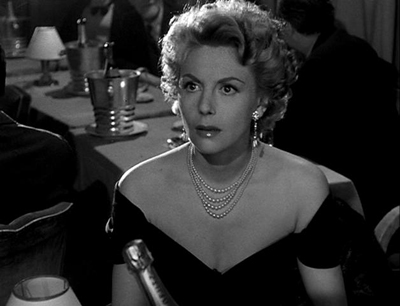
Mado is upselling some poor schlub a bottle of champagne (her current boyfriend owns the club) and Tony dispatches with this lowlife with as much contempt as possible. Like every would-be tough guy dreams, he snarls, "Coming Mado?" and she has no choice but to follow. So far, this is a scene Mitchum would kill. But the next shot is Tony and Mado at the threshold of his new, very downscale apartment, and their conversation is about how crappy his setup is. He makes an attempt to regain control of the situation, sitting down at the kitchen table and idly playing with a deck of cards. But it's a cheap table, and in a film that opens with a card game, and echoes the image of players around a table over and over again, it seems worth noticing that the cards he draws—a deuce and a jack—aren't worth holding.
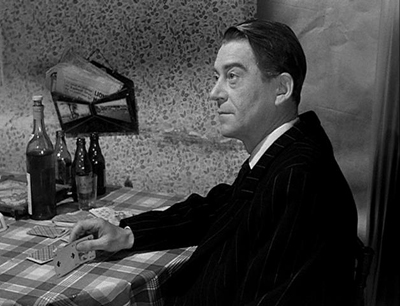
And here's how Dassin recreates the two-shot from the club, as Tony makes Mado give him her jewelry. Shot:
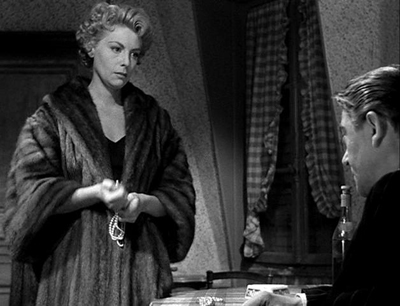
Reverse shot:
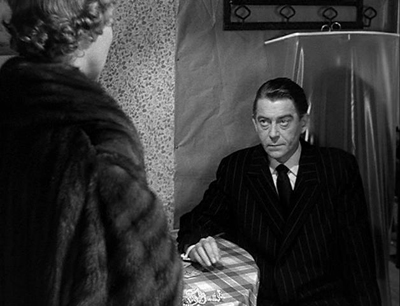
A sallow man in a bad suit bullying a woman who fears and loathes him. When the violence comes (and you knew it was lurking there, didn't you?), the camera doesn't even follow him. It stays static, for the same reason that Scorsese's camera doesn't follow Travis Bickle when he's making his desperate phone call: pity and disgust.
Even when they're not whipping them with belts, Dassin makes a point of showing how deliberately Tony and the other thieves marginalize the women in their lives. There are two separate scenes in which Mario tells his wife or lover to go to bed while the men discuss business. He literally calls her pet, and pats her on the cheek.
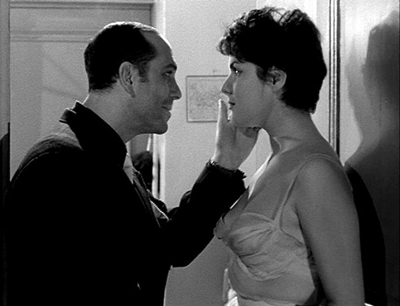
And he's one of the nicer characters. There's a lovely wordless sequence before the heist showing the men leaving their various women, none of whom seem particularly happy about it; (one is caring for their sick child, another washing dishes). And when things go south, Dassin lingers over the ways the women get sucked into the consequences of the stupid game the men are playing.
But Rififi isn't Goodfellas and nobody watches it to study Dassin's visual strategies for undercutting his characters' bogus machismo. For one thing, with the exception of Tony, Dassin does allow them a certain amount of charm.2 For another, focusing on the genre-subverting aspects of Rififi is kind of like writing a yelp review of the food on the Space Shuttle: it might be interesting, but it's a little beside the point. The rest of the film is a disposable wrapper around the heist sequence that takes up its central third. It's long, it uses no dialogue or soundtrack, and it's one of the greatest pieces of pure visual storytelling in cinema. In his essay for the DVD insert, Jamie Hook makes the case that this section is "a paean to work," that the team of robbers exceling at what they do has a certain spiritual aspect. Anyone who knows me knows that if there are two things I love, they're work and spirituality. Which is why I want to talk about game theory.
If you want to be really bloodless about it, you can look at any narrative through this lens: The author or authors have all of the information while the characters and audience have exactly as much as the authors allows. No matter what type of narrative, the audience will make intuitive leaps, try to anticipate what's coming next. This is a game the audience loves to lose, as long as they don't think they've been cheated. At this point you've probably decided I'm the Laurence Perrine of film criticism and ordered your students to rip this essay right out of the blog.3 But look: there are entire genres whose success depends entirely on precisely controlling the moment when the audience understands what it's seeing. And generally speaking, films do a much, much worse job of this than novels.
To be fair to cinema, the written word has a huge advantage: the phrase "he thought." For all the innovations in narrative technique filmmakers have developed over the last hundred years, writers can portray the inner lives of their characters simply by, well, portraying it. Film can't do this, or at least rarely does it gracefully. You can see how much of a handicap this is by looking at situations where a filmmaker needs the audience and an onscreen character to reach the same conclusion at the same time. We all know the film grammar: replay dialogue on the soundtrack while zooming in on the character looking thoughtful until the audience figures it out (then keep looping dialogue for about thirty seconds more). This was already a cliché twenty years ago, which is to say before this or this or God forbid, this. You can make the case that this particular technique is the best solution to a difficult problem, right up until you see the heist sequence in Rififi, a master class in carefully controlling what the audience and characters know, and when.
Everyone talks about the heist itself, and it is a masterpiece, but I don't think it would work without the sequence that immediately precedes it, which gets virtually no attention. The gang has already scoped out the jewelry store they're robbing and obtained the same model of alarm (there's a nice cut from a close-up of the alarm on the wall of the jewelry store to the duplicate as the thieves set it up). They're all assembled in the basement, probing for a weakness. There are two ways this sort of scene usually plays out. The first is to establish that the alarm is impossible to beat, cut away while no solution has been found, and during the actual heist reveal some ingenious workaround or last-minute improvisation. The second approach is to have one gang member immediately see the solutionᾹto use it as a character moment. Dassin does something different, which I can't say I've seen before or since: he spends six full minutes showing exactly how the thieves figure out how to defuse it. The problem is solved in a sudden flash of insight, but it's hard-won: Dassin shows failure after failure as they feel their way around the problem, figuring out the things that don't work as they move closer to something that does. Can the alarm be shut off? No. Can the power be cut? Again, no. What if I open the alarm door first? Nopity nopity no. Fine, jerkface, but if the door were open, could I stop the bell from ringing? Well, maybe, but you can't get the door open, can you? It's a process of iterative failure that very slowly creates the necessary conditions for a breakthrough. It doesn't make any of the characters look like a superhero, but it's how complicated problems are actually solved. In that sense, Rififi has a flash of humanism that is rare for a noir.
So that's a scene where the characters on-screen and audience need to reach the same point at the same time. But instead of having a voiceover ("Remember the fire extinguisher... extinguisher... extinguisher") or a super-genius character who explains after the fact what he's realized, Dassin encourages the audience to think through the problem concurrently with the characters. And the minute that Tony spots the fire extinguisher that will allow him to muffle the alarm, we know exactly what he's going to do with it.4
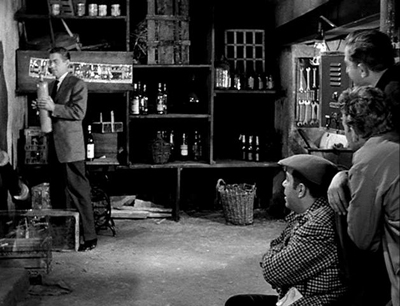
The unusually long problem-solving sequence pays off during the heist itself, where the information state is different. In the previous sequence, neither the burglars nor the audience know how to defuse the alarm—they're on the same page. During the heist, the onscreen characters have all the information; they know their parts so well that they don't even have to talk to each other. It's the audience that has realization after realization as the plan unfolds. This is handled masterfully: again and again Dassin shows us an obstacle, shows us a very strange approach that doesn't seem to address the problem at all, and then at the last minute reveals the solution. But here's the thing: as each obstacle falls to some ingenious Rube Goldberg contraption or other, we value the solutions even more because, after the alarm sequence, we know how they were arrived at: the same long process of trial and error and error and error. The complicated device used to drill the safe (invented for the film) is a perfect example; not only do we realize how it works exactly when Dassin wants it to and not before, but its component parts actively mislead the viewer as it is assembled.

Better yet is the umbrella, which I won't spoil for anyone who hasn't yet seen the film, but is one of the most delightful moments in all of cinema.
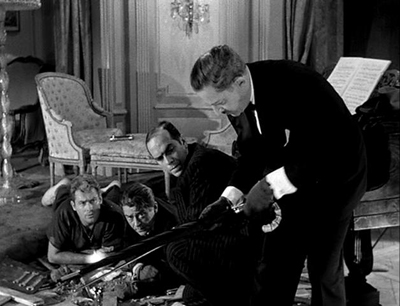
If you're the sort of reader who tries to make intuitive leaps to figure out where the author is headed, you'll already have guessed that there's one information state I haven't dealt with yet.5 And as it happens, the film's final act deals with situations where the audience has the information and the characters don't. There are basically three ways to use this configuration: comedy, which isn't our concern here, horror ("Don't go in the basement!") and suspense ("Find a working pay phone before you make a terrible mistake!"). Dassin uses both of the latter approaches as we watch things unravel, leaving us helpless to do anything but yell at the screen. This is much less rare than what's going on in the heist, but as obligatory scenes go, the ending is perfectly executed. As with the early scenes in the film, the interesting questions here have to do with tone. So does Dassin give his characters a certain amount of tragic grandeur as the rules of their stupid little game start constricting around them? Well, yes:

And no:
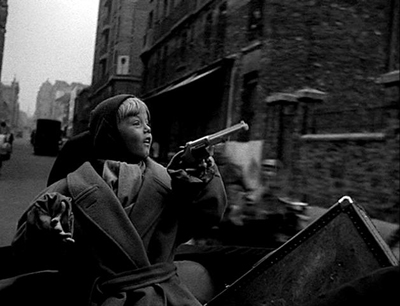
Randoms
- Dassin's performance in the film—he cast himself as Cesar when the original actor's deal fell through—is worthy of another essay. Also worthy of its own essay (and probably a year or so of therapy): Dassin, ratted out to HUAC, casts himself as a rat who gets his. Presumably not Edward Dymtryk's favorite scene.
- As with its parody Big Deal on Madonna Street, the location shooting is spectacular, from the bar where the opening card game is played to the final street tour of Paris. Also worth noting: despite the fact that one is comedy and one tragedy, the buffoonery of the Italian characters in the two films is not all that different.
- If you think Dassin was being a little hard on Le Breton's novel, consider that one of the elements he cut was apparently necrophilia.
- Apologies for the extended absence. I've been working on other things, and occupied with personal matters (happy personal matters!) of late.
1"Day 489,598. Still being eternally devoured in Satan's jaws. Dante and Virgil have been gone for a week."
2What Tony loses in charm he gains in "having the first clue what's happening around him," which is its own kind of statement.
3This is probably as good a place as any to confess that my high school English teacher used Sound and Sense in the 1990s, and I taught high school English students from it in the aughts. Perrine's area-of-a-rectangle analogy really is terrible, but there's value in a book that contains clear and straightforward explanations of the things in poetry that are clear and straightforward (meter, for example, completely absent from state English textbooks) and still has room for things as unclear and wonderful as Larkin and Auden, Yeats and Donne.
4Significantly, only one of the other three members of the gang figures this out: Cesar, who rises to take Tony's coat off while the other two boneheads look on in wonder. Leave it to the director to make sure his character is at least the second-smartest person in the room.
5Yes, technically there are two remaining states (and bravo, pedant!), but the case where audience and characters have the same information is (A) trivial and (B) the end point for the other cases discussed.


7 comments:
Regarding note 5, I think you'd already covered the knowledge state where audience and characters have the same information in the passage concerning Tony's breakthrough. Both character and audience reach the same conclusion concurrently, so that plot part belongs to that category, I think.
By the way, I'm a huge fan of your work; terrific stuff. You routinely accomplish the remarkable feat of combining slick, casual prose with in-depth analysis of content and form. And you're sense of humor is a knock-out—the Star Wars thing was fantastic—.
Keep the writing coming!
I'm going to wait to finish reading until I've seen the movie, but I wanted to say thanks for making me laugh out loud with that parenthetical -- "then keep looping dialogue for about thirty seconds more".
Great, great essay.
Glad to see you are back again! I hate to see so much time between essays, but if that's what it takes to keep delivering such high quality, then it is worth it!
Really enjoyed this essay. Great to have you back.
Tangentially, I would love to see you unpack your comments on Star Wars Episode I sometime. I've never seen a consideration of that movie as any kind of deconstruction. My gut instinct is that such an argument is likely to be giving Lucas too much credit, but I'm certainly open to setting aside my prejudice to hear it.
The usual suspects -- hilarious. Made me laugh out loud (as opposed to LOL which is basically meaningless punctuation.) -- shawn
Another reader thrilled to have you back (and happy to hear about the happy personal matters)!
It's been a long time since I've seen this one, so I guess a rewatch is in order.
thanks for this post
Best cccam server
Post a Comment